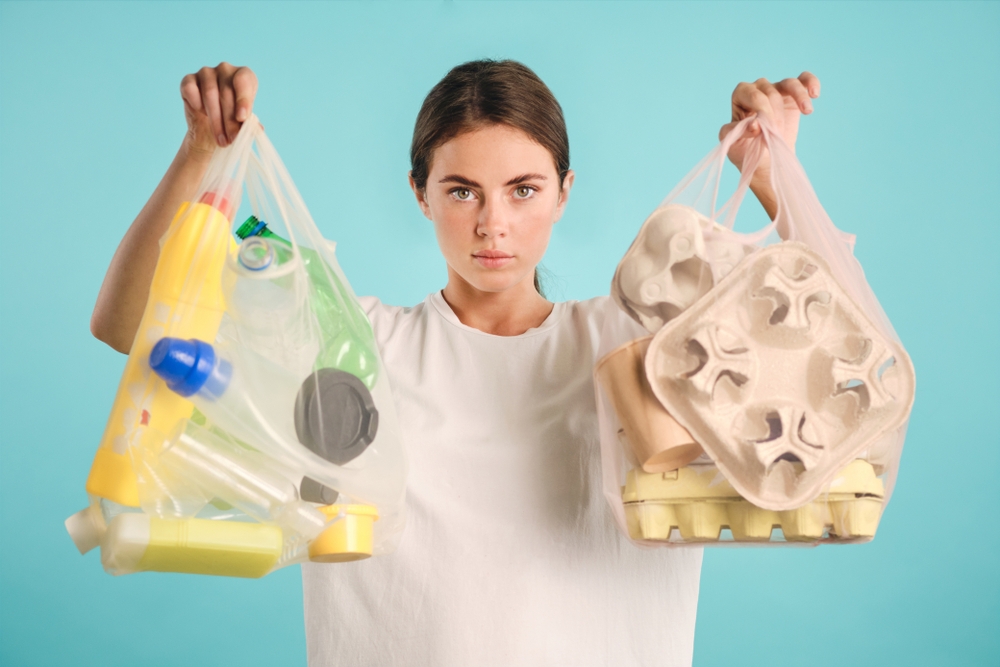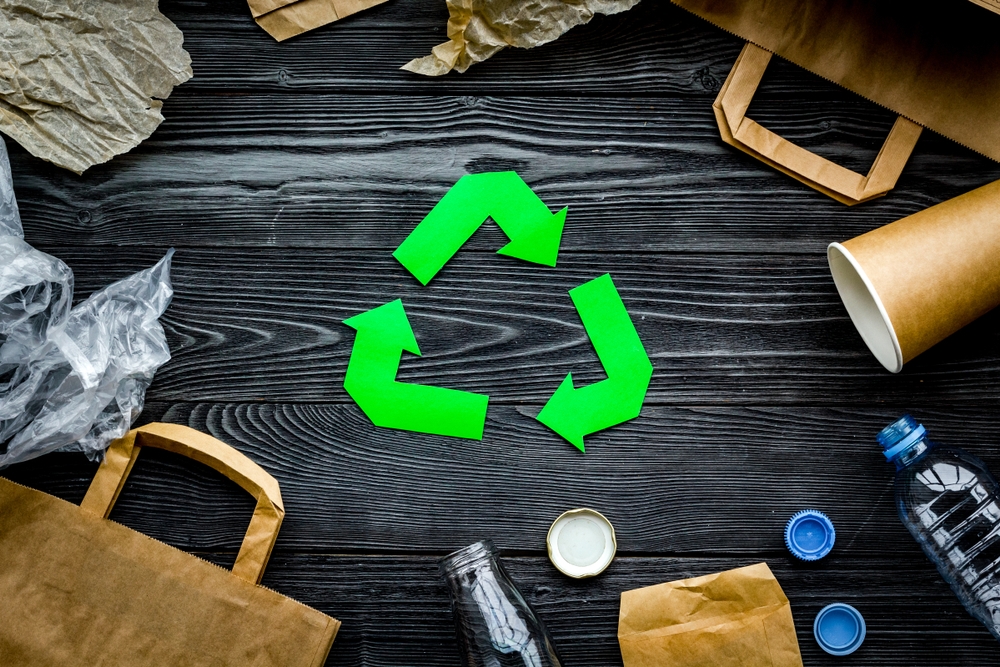Consumer Attitudes Towards Takeaway Packaging
By Morten Numrich · 26. April 2024
What governs consumer attitudes towards takeaway packaging, eco-consciousness or convenience?
This article explores the intricate relationship between environmental concerns, practicality, and how these factors shape purchasing behavior.
From demographic influences to economic incentives, gain a comprehensive understanding of the forces at play in the realm of sustainable takeaway packaging.
Understanding the Disconnect: Consumer Intent vs. Action

girl holding packages sorting plastic
Do you recall the last time you promised yourself to make more eco-friendly purchases? Now think about how often you’ve actually followed through on that promise.
If there’s a gap between your intent and action, you’re part of a bigger puzzle. In fact, while over 82% of consumers express a willingness to choose eco-friendly products, only about a quarter actually do so.
Why is there such a major gap between consumer intent and action? It’s not that consumers don’t care.
In fact, more than half express concerns about single-use plastics in takeaway packaging. Yet, the convenience of a quick grab-and-go meal often trumps these eco-friendly intentions.
It’s a conundrum, isn’t it? A recent pa consulting survey reveals some factors that fuel this disconnect. Let’s delve deeper into them.
The role of convenience culture
In our fast-paced world, convenience is king. We thrive on instant gratification – meals that are ready in minutes, products delivered to our doorstep, and services available at the click of a button. But when it comes to sustainability, this convenience culture can be a stumbling block.
Despite environmental interests, consumers don’t prioritise sustainable options, as convenience often outweighs their intentions to purchase eco-friendly products.
Imagine this: you’re on your way to a picnic, and you’ve forgotten your reusable containers. Would you go back home to get them, or would you just buy some disposable ones from a nearby store?
If you chose the latter, you’re not alone. For many, the struggle of remembering, cleaning, and storing reusable packaging is a significant barrier to its adoption.
Factors influencing consumer decisions
If convenience is king, then ease of purchase is the queen. When it comes to turning eco-friendly intentions into actual buying behavior, the simplicity and low effort required play a significant role.
Imagine you’re at a supermarket, and you’re faced with two options – a regular plastic bottle of soda and a glass one with an eco-label. Which one would you choose? The one that’s easier to carry and dispose of, perhaps?
Unfortunately, this hesitation isn’t uncommon. Despite recognizing the importance of eco-friendly packaging, a majority of consumers do not prioritize it when making purchasing decisions.
But what if we told you that your choices could help make a difference? That’s where financial rewards come in.
The importance of financial rewards in driving sustainable choices
When it comes to encouraging sustainable choices, it can speak volumes. Financial rewards, such as cost savings and incentives, can significantly motivate consumers to opt for sustainable takeaway packaging options.
Consider this: would you be more likely to bring a reusable bag if you knew you’d be charged for a plastic one?
Taxation of single-use plastic bags is a regulatory measure that has demonstrably led to their decreased usage.
In essence, when the carrot (financial rewards) beats the stick (additional costs or effort), people are more likely to be incentivised by financial rewards and make sustainable choices.
Demographic Variations in Sustainable Packaging Engagement

Sustainable Food Packaging
Sustainable packaging isn’t a one-size-fits-all proposition. Just as our preferences for cuisine and fashion vary, so too do our attitudes towards sustainable packaging.
These attitudes are shaped by a myriad of factors, from age and geographic location to education level.
It’s like choosing a cup of coffee. Some of us prefer a no-nonsense black coffee, while others fancy a vanilla latte with extra foam.
Similarly, some consumers, particularly those from younger generations, prioritize sustainability over brand names, while others may be influenced more by the ease of purchase or monetary rewards.
Let’s explore these variations in more detail.
Age and generational differences
Meet Generation Z, the eco-warriors of the consumer world. Born between 1995 and 2010, this generation prioritizes sustainable purchases over brand names and influences other generations to make sustainability-focused buying decisions. Who needs a superhero when we have Gen Z, right?
Armed with their tech-savviness, Gen Z leverages digital platforms to make informed purchases that favor environmentally responsible options.
Their sustainable consumer practices have prompted a notable increase in the spending on sustainable products across different generations.
Geographic variations
The world is a vast place, with diverse cultures, economies, and environments. Consequently, consumer attitudes towards sustainable packaging can vary greatly between different countries and regions.
Let’s take a trip across the globe. In Europe, many consumers have reservations about the hygiene of reusable packaging, with 78% worried about cleanliness, especially during the Covid-19 pandemic where safety took precedence over sustainability.
On the other hand, in some Asian countries, there’s a growing trend of using biodegradable materials such as bamboo and palm leaves for packaging. So, as we see, geography matters!
Reusable and Refillable Packaging: Perceptions and Challenges

Sustainable Materials in Reusable Packaging
The path to sustainability isn’t always lined with roses. While reusable and refillable packaging holds promise for a greener future, it brings its own set of perceptions and challenges.
From concerns about cleanliness to the inconvenience of returning and storing these items, there are several hurdles to overcome.
Addressing hygiene concerns
Cleanliness is next to godliness, or so the saying goes. So, it’s no surprise that hygiene is a top concern when it comes to reusable packaging.
From potential contamination to reusable packaging’s cleanliness maintenance, these concerns can pose significant barriers to the adoption of reusable packaging.
But here’s the silver lining: by clarifying recycling processes and assuring cleanliness, we can foster consumer trust in reusable packaging solutions.
Overcoming storage and return obstacles
Imagine owning a fancy sports car but having no garage to park it in, or a designer dress with no closet space to hang it. Frustrating, right? The same goes for reusable packaging.
If the effort needed to return it overshadows its benefits, it can hinder its widespread adoption. But with a bit of ingenuity and planning, these obstacles can be overcome.
Imagine a world where returning your reusable packaging is as easy as dropping it in a designated bin at your local supermarket, or where storage solutions for these items are built into your kitchen design.
The Role of Businesses and Government in Shaping Consumer Attitudes
If consumers are the actors in the sustainability play, businesses and governments are the scriptwriters.
They play a vital role in shaping consumer attitudes towards sustainable packaging and planet positive consumer behaviour, setting the stage for eco-friendly practices.
From implementing regulations that encourage sustainable choices to promoting corporate responsibility and designing incentive programs, businesses and governments have the power to transform the narrative around sustainable packaging.
Implementing effective regulations
What if every takeaway food order came with a small tax for its plastic packaging? Would that make you think twice about your choices?
Regulations that prioritize packaging circulation mechanisms over options like taxation can significantly influence consumer attitudes towards sustainable packaging.
By establishing and enforcing unified standards for food packaging, governments can ensure consumer confidence in packaging circulation and foster sustainable practices.
Promoting corporate responsibility
Imagine a world where businesses not only aim to maximize profits but also minimize their environmental footprint.
This is the essence of corporate responsibility – a commitment to ethical practices that benefit not only the organization but also the environment and society at large.
From choosing sustainable packaging materials to participating in reuse and refill programs, businesses can demonstrate corporate responsibility in various ways.
By adopting transparent and environmentally conscious initiatives, they can also play a critical role in shaping consumer attitudes towards packaging sustainability.
Innovations in Sustainable Takeaway Packaging

Sustainable Food Packaging
Innovation is the lifeblood of progress, and when it comes to sustainable takeaway packaging, it’s bringing a wave of positive change.
From eco-friendly materials to reusable containers, the landscape of takeaway packaging is shifting towards a more sustainable future.
Let’s explore some of these innovative strides in sustainable takeaway packaging, and how they’re not only addressing environmental concerns but also redefining the way we think about packaging.
In fact, sustainable packaging nearly four times more eco-friendly options are being developed.
Biodegradable and compostable materials
Remember the last time you enjoyed a meal in a bamboo bowl or sipped a drink from a sugarcane straw? If you haven’t yet, you might soon!
Sustainable packaging solutions are increasingly being developed with eco-friendly materials like palm leaves, sugarcane by-products, and even seaweed, which are all biodegradable.
These materials not only reduce waste and utilize renewable resources, but also offer businesses an opportunity to demonstrate corporate responsibility by aligning with environmental regulations and customer expectations.
So, next time you enjoy a takeaway meal, don’t be surprised if your food arrives in a container made from recycled food waste or a bowl you can actually eat!
Reducing plastic use
If plastic were a villain in the sustainability saga, then its arch-nemesis would be the initiatives aimed at reducing its use.
Governments worldwide, concerned about plastic packaging, are implementing bans on single-use plastic packaging, prompting the food service industry to explore and adopt sustainable alternatives.
From substituting traditional plastics with materials like sugarcane by-product bagasse and wood pulp-derived NatureFlex, to proposing interactive systems that allow consumers to choose between paying an environmental cleanup tax or participating in packaging return programs for reuse, businesses are stepping up to the challenge.
With these initiatives, reducing food packaging waste, especially plastic waste from takeaway packaging, is becoming less of a dream and more of a reality.
Circular economy models for packaging
Ever heard of the circular economy? It’s a model that aims to eliminate waste and promote the continual use of resources, and it’s making waves in the world of packaging.
Circular economy models for packaging involve collaboration between various stakeholders, including:
- Policymakers
- Manufacturers
- Retailers
- Consumers
The goal is to prioritise sustainable packaging, ensuring that materials stay in use for as long as possible through reuse packaging, reducing the need for new resources and minimizing waste.
With easily recyclable materials such as:
- paper
- cardboard
- glass
- metal
- recyclable plastics like PET
It’s important to note that unrecyclable materials are not included in this list.
at the heart of these models, they represent a sustainable approach to packaging that goes beyond just reducing waste.
So, next time you recycle a plastic bottle or return a reusable container, remember, you’re a crucial part of this circular journey!
Frequently Asked Questions
What are some challenges associated with reusable and refillable packaging?
Reusable and refillable packaging come with challenges such as hygiene concerns, the effort to return and store items, and the need for effective incentive programs. Ultimately, these obstacles require thoughtful solutions to ensure widespread adoption.
How are businesses and governments shaping consumer attitudes towards sustainable packaging?
Businesses and governments can shape consumer attitudes towards sustainable packaging by implementing regulations, promoting corporate responsibility, and designing incentive programs. So, it’s not just on us consumers, but on them too!
What are some innovations in sustainable takeaway packaging?
Takeaway packaging innovations include using biodegradable materials, reducing plastic usage, and adopting circular economy models for reuse and recycling. It’s all about sustainability and reducing waste.

